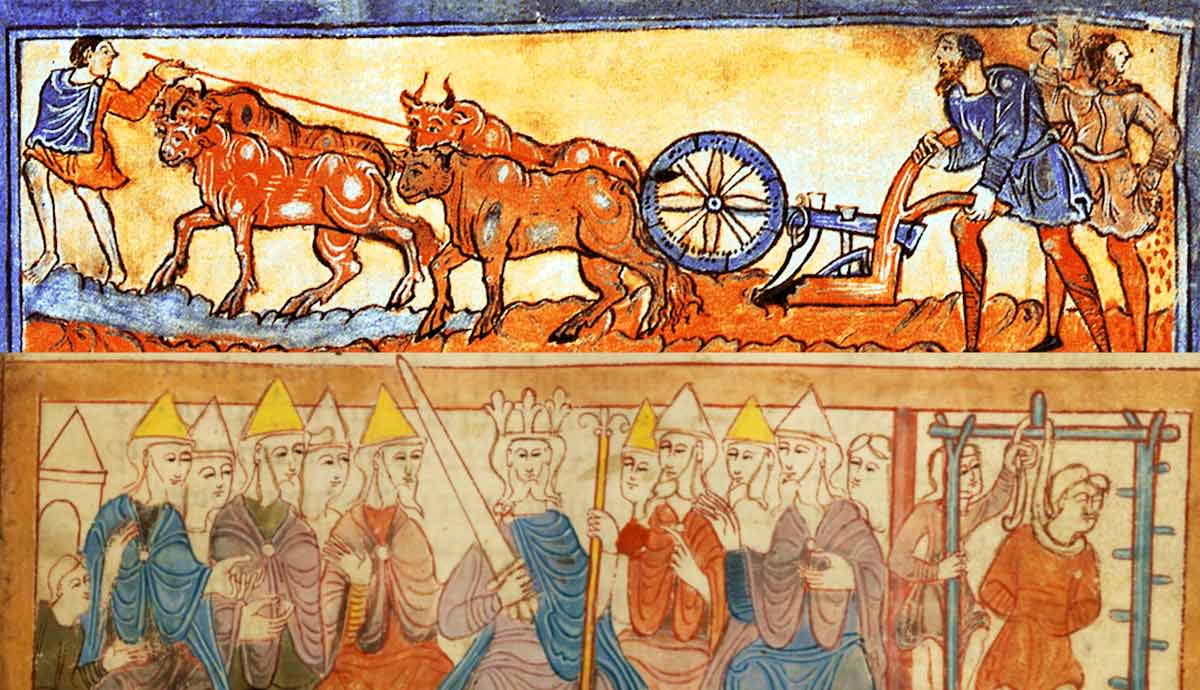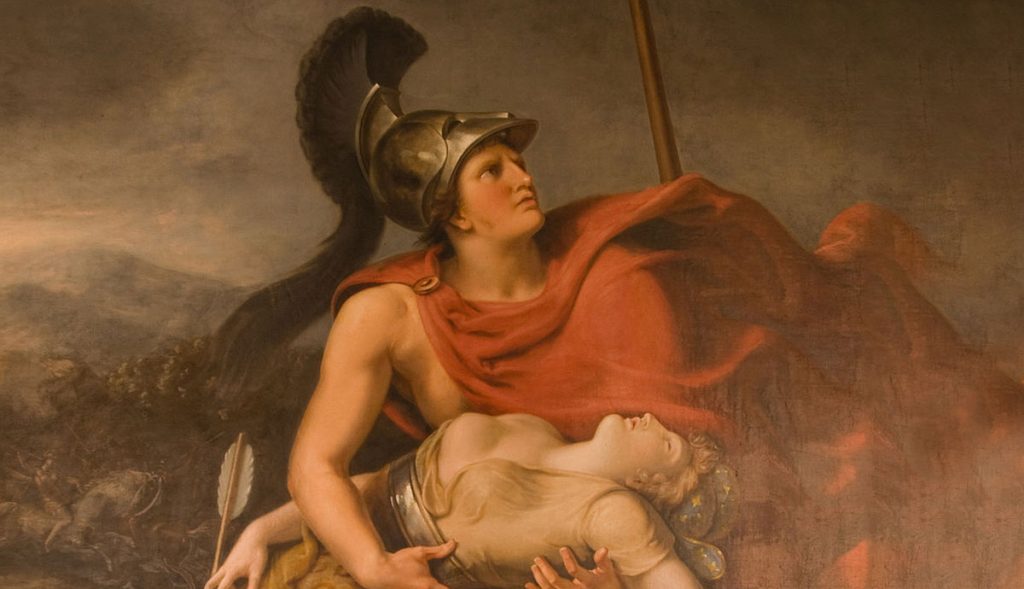Long before William the Conqueror set foot on English soil, Anglo-Saxon England had forged a complex, vibrant society. Between the fall of Roman rule (early 400s CE) and the fateful year 1066, layers of Germanic, Celtic, and Christian traditions blended into something distinctly English.
Yet a single day—the Battle of Hastings—re-wired almost every institution: landownership, law, language, and architecture. Understanding what the Normans “changed” first requires seeing what was already there.
🏛️ Anglo-Saxon Social Pyramid
Anglo-Saxon England looked hierarchical but surprisingly elastic:
- Cyning (King). Not a divine monarch but “first among war-leaders,” elected (in theory) by nobles, crowned by bishops.
- Ealdormen & Earls. Regional governors commanding shire militias; interchangeable with Scandinavian “jarls” in the Danelaw.
- Thegns. Roughly 4,000 local gentry owing military service for land. A successful ceorl could rise to their ranks—social mobility by loyalty.
- Ceorls. Free peasants owning or renting small plots; backbone of the economy and the fyrd militia.
- Thralls/Slaves. About 10 % of the population—war captives or criminals—working estates or households.
📷 Insert Image – “Illustration from the 11th-century Hexateuch showing king, thegn, and peasant.”
Caption: “Anglo-Saxon status in a single medieval sketch.”
📜 LEARN THE PAST
💰 Fields, Fairs, and Silver Pennies
Anglo-Saxon wealth began in the soil:
- Open-field farming dominated the Midlands, with communal crop rotation.
- Manorial courts set by-laws on hedging, grazing, and labor rents, but outright serfdom was still rare.
- Geld (Land-tax) financed royal armies; unlike loose Viking tribute, it was assessed in silver pennies and enforced by shire reeves—prototype sheriffs.
- Trade hubs such as London (Lundenwic), York (Eoforwic), and Southampton (Hamwic) exported wool and imported Frankish wine, Islamic glass, even Byzantine silks via Scandinavian brokers.
📷 Insert Image – “Hoard of Æthelred II pennies.”
Caption: “Standardized silver coins fueled a surprisingly cash-savvy countryside.”
✝️ Faith, Learning, and Law
Christianity arrived with Augustine of Canterbury (597 CE) and, by c. 1000, saturated daily life: parish tithes, saints’ days, and Latin-literate clergy. Monasteries doubled as scriptoria, copying Gospel books and heroic epics in Old English (think Beowulf). Kings issued law codes infusing biblical morality—King Alfred’s preamble literally quotes Exodus.
Law hinged on oath-taking and wergild (monetary compensation for injury or death). Crimes were personal wrongs, not state offenses. A ceorl’s life was priced at 200 shillings; a thegn’s, six times higher—blood money, but with arithmetic.
📷 Insert Image – “Page from the Lindisfarne Gospels.”
Caption: “Hiberno-Saxon art: where Celtic knots meet Christian scripture.”
🛡️ Defense in Depth
From the 870s, Viking armies forced Anglo-Saxon kings to innovate:
- Burhs. Fortified market-towns every 20–25 miles allowed rapid royal response. Many modern English towns—Oxford, Wallingford—trace street grids to Alfred’s burh system.
- Fyrd. Rotating militia of free men; thegns supplied horses for mobile scouts while ceorls manned palisades.
- Housecarls. Elite axe-wielding professionals (late 11th c.) answering directly to the king, foreshadowing Norman knight retinues.
By 1066 England fielded perhaps 13,000 trained troops—respectable but thinly spread across 15 million acres.
📷 Insert Image – “Reconstructed Anglo-Saxon burh earthworks (e.g., Wareham).”
Caption: “Grass-covered ramparts that once checked longships.”
📜 Government without Bureaucracy
The Witan (Witanagemot)—a council of bishops, abbots, and earls—advised the king on war and succession. Its consent lent legitimacy; without it, a “king” was just a warlord. On the ground, shire and hundred courts met every four weeks beneath open skies, led by the sheriff (scírgeréfa). Justice was oral, swift, and rooted in community memory—no filing cabinets, but everyone knew the score.
⚔️ 1066—Three Armies, One Crown
January. Edward the Confessor dies childless; the Witan backs Harold Godwinson.
September. Harold crushes Norwegian King Harald Hardrada at Stamford Bridge—then speed-marches south.
14 October. Battle of Hastings: William of Normandy’s combined archers, infantry, and cavalry outmaneuver the weary English shield-wall. Harold falls; the earls scatter.
📷 Insert Image – “Bayeux Tapestry panel: Norman cavalry at Hastings.”
Caption: “Needlework newsreel: the moment cavalry trumped shield-wall.”
🏰 Norman Shock Therapy
William’s victory was military; his consolidation was administrative:
- Land Grab. By 1086, barely 5 % of estates remained in English hands; 200 Norman barons controlled the rest, holding fiefs per baroniam—conditional on knight service.
- Castles. Motte-and-bailey forts sprouted—Windsor, Durham, Dover—projecting stone authority where burhs once stood.
- Domesday Book (1085–86). A kingdom-wide audit listing 13,418 settlements: who owned what on Christmas Day 1066 and “now.” Tax shock and legal baseline in one parchment.
- Feudal Hierarchy. Thegns became minor tenants-in-chief or lost status; ceorls slid toward villeinage, owing labor services to Norman lords.
📷 Insert Image – “Opening folio of the Domesday Book (Exchequer copy).”
Caption: “England’s first national database—ink, quills, and fiscal fear.”
🗣️ Words, Stones, and Genes
Language. Court French layered over Old English vocabulary: beef (boeuf) vs. cow, mansion vs. house, justice vs. doom. By 1400 the stew became Middle English.
Architecture. Romanesque (Norman) churches replaced timber halls—thick walls, rounded arches, zig-zag stone carvings (e.g., Durham Cathedral).
Law. Trial by combat joined older oath-swearing; writs in Latin accelerated a documentary culture.
Identity. For 150 years, England’s elite spoke French, prayed in Latin, and commanded English peasants—a tri-lingual society that eventually synthesized into a unique kingdom.
📷 Insert Image – “Nave of Durham Cathedral.”
Caption: “Stone gravity: Norman confidence set in mortar.”
🌄 Long-Term Legacies
- Central Royal Power. Shire sheriffs now answered to a far stricter Exchequer; rebellion meant castle sieges, not polite wergild.
- Common Law Roots. Norman writs merged with Anglo customs, birthing precedents still cited today.
- Parliamentary Germ. The Witan faded, but its consultative spirit resurfaced in 13th-century parliaments—an Anglo-Norman hybrid.
- Cultural Fusion. From cuisine (rabbit stew) to names (William, Richard, Alice), England became “Anglo-Norman,” then simply “English” again—changed forever, yet recognizably continuous.
📝 Conclusion – Conquest, Continuity, and the Birth of England
The Norman Conquest did not erase Anglo-Saxon society; it overlaid it—new elites, new castles, new words, but built on fields ploughed by ceorls, laws debated in shire moots, and a Christian worldview already centuries deep. Over time the two cultures fused, giving us the English language, common law, and a monarchy paradoxically constrained by precedent. If Anglo-Saxon England supplied the roots, 1066 grafted on the branches that would flower into the later medieval kingdom and, ultimately, the modern British state.










































